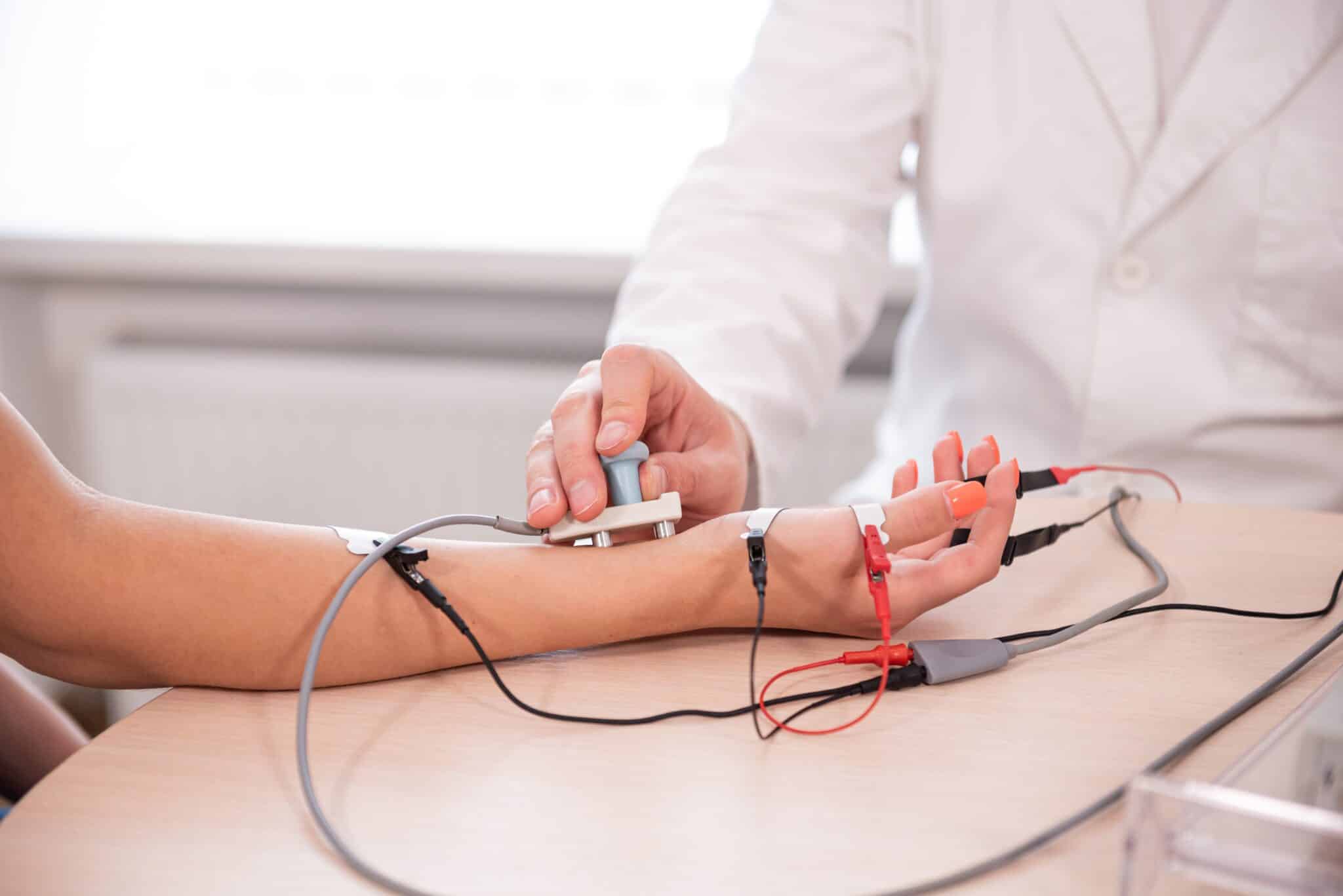Summary
A nerve conduction study (NCS), also known as a nerve conduction velocity (NCV) test, is a diagnostic procedure used to assess the function and health of nerves in the body. If you’re experiencing symptoms like pain, numbness, tingling, or weakness, your doctor may recommend an NCS to help diagnose and evaluate nerve-related conditions.
During a nerve conduction study, small electrical currents are applied to specific nerves using surface electrodes placed on the skin. These electrical impulses stimulate the nerves, and the resulting responses are recorded and analyzed.
Nerve conduction studies are often used to diagnose and evaluate conditions affecting the peripheral nervous system, such as peripheral neuropathy, carpal tunnel syndrome, radiculopathy, and other nerve injuries or disorders. The test is generally safe and non-invasive, although it may cause mild discomfort or a sensation similar to a small electric shock during the procedure.
What is a Nerve Conduction Study (NCS)?
A nerve conduction study (NCS) is a medical test used to assess the health and functioning of the peripheral nervous system, which includes the nerves outside the brain and spinal cord. It is a diagnostic procedure that helps in evaluating nerve damage, detecting nerve-related disorders, and determining the extent and location of nerve injuries or abnormalities.
During a nerve conduction study, small electrical currents are applied to specific nerves using surface electrodes placed on the skin. These electrical impulses stimulate the nerves, and the resulting responses are recorded and analyzed.
When is NCS Used?
A nerve conduction study (NCS) is used in various clinical scenarios to evaluate the functioning and integrity of the peripheral nervous system (nerves outside of the brain and spinal cord).
Radiculopathy
Radiculopathy refers to the compression or irritation of nerve roots as they exit the spinal cord. Sciatica, for example, is a type of radiculopathy. NCS can help determine the level and severity of the nerve root involvement and differentiate between different levels of radiculopathy.
Nerve Compression Syndromes
NCS is commonly employed to diagnose conditions such as carpal tunnel syndrome, cubital tunnel syndrome, and tarsal tunnel syndrome. These conditions involve the compression or entrapment of nerves, leading to symptoms like pain, numbness, tingling, and weakness. NCS helps in confirming the diagnosis and assessing the severity of nerve involvement.
Nerve Injuries
NCS plays a crucial role in evaluating nerve injuries, such as those resulting from trauma, surgery, or other causes. It helps in localizing the site of injury, assessing the extent of nerve damage, and monitoring the recovery progress over time.
Muscle Disorders
NCS, along with electromyography (EMG), is used to diagnose and differentiate between muscle disorders, such as myopathies and neuromuscular junction disorders. It provides information about nerve-to-muscle communication and the electrical activity within the muscles.
Pre-surgical Assessment
NCS may be conducted before certain surgical procedures, especially those involving nerves or the neuromuscular system. It helps in identifying any pre-existing nerve abnormalities, determining baseline nerve function, and assisting in surgical planning.
What to Expect During the Test
If your healthcare provider has recommended an electromyography (NCS) test, it’s natural to have questions and concerns about what to expect. We’ll discuss the typical steps involved below.
During a nerve conduction study (NCS), here’s what a patient can generally expect:
- Preparation: You will be asked to lie down or sit in a comfortable position. The area to be tested will be exposed, such as your arm, leg, or another specific body part. The technician or doctor will attach surface electrodes (small adhesive patches) to your skin at specific points along the nerve pathway being evaluated. These electrodes will send and receive electrical signals.
- Stimulation: The technician will use a handheld device to deliver a small electrical impulse to the nerve being examined. You may feel a mild, brief tingling sensation or a twitch in the muscle associated with the stimulated nerve. While the sensation might be slightly uncomfortable, it is usually tolerable.
- Recording: Other electrodes placed along the nerve pathway will record the electrical responses generated by the stimulated nerve. The technician may need to move the electrodes along the pathway to test different segments of the nerve.
- Post Test: After the NCS, you can resume your normal activities without any restrictions. There is typically no recovery period or downtime required.
How Long Does a NCS Take?
The length of the NCS procedure varies depending on the area being tested. It can last anywhere from 15 minutes to an hour.
Does it Hurt?
When the electrical impulse is delivered to the nerve, you may experience a brief sensation of tingling, warmth, or a muscle twitch in the area being tested. Some people describe it as feeling like a small electric shock. The intensity of the sensation can range from mild to slightly uncomfortable, but it should not be overly painful.
Final Thoughts
Overall, NCS is a valuable tool that provides important information for diagnosing and managing various conditions affecting the nerves. By understanding the procedure and potential considerations, we hope you feel more informed and prepared when undergoing this diagnostic procedure.
